Chapter 1: Using Geography Skills Section 1: Understanding



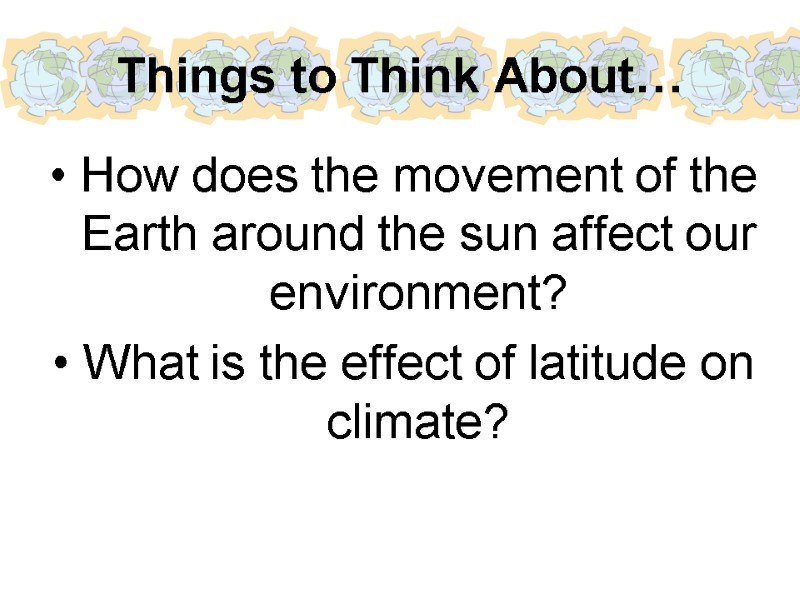


















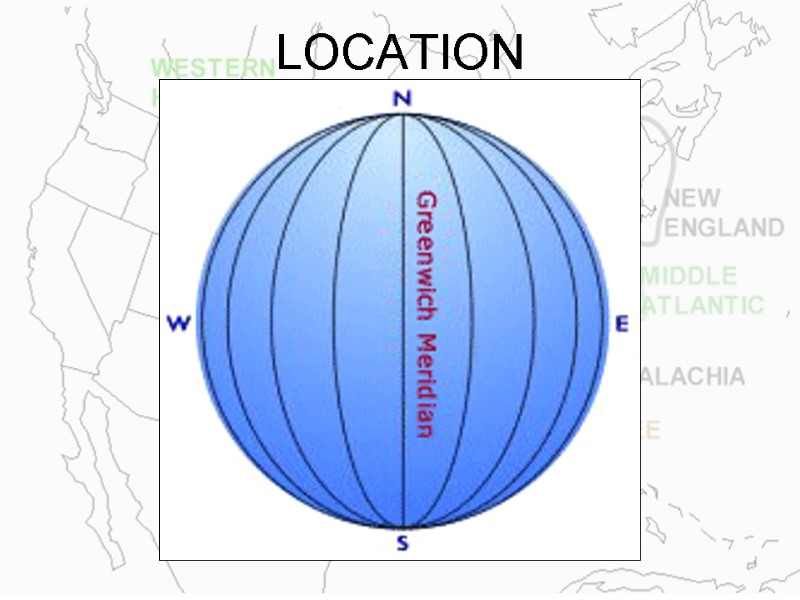





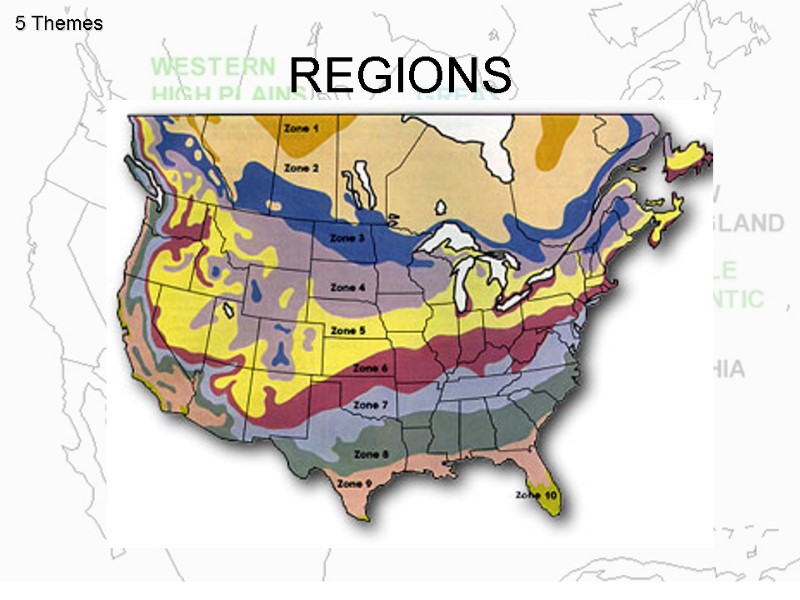



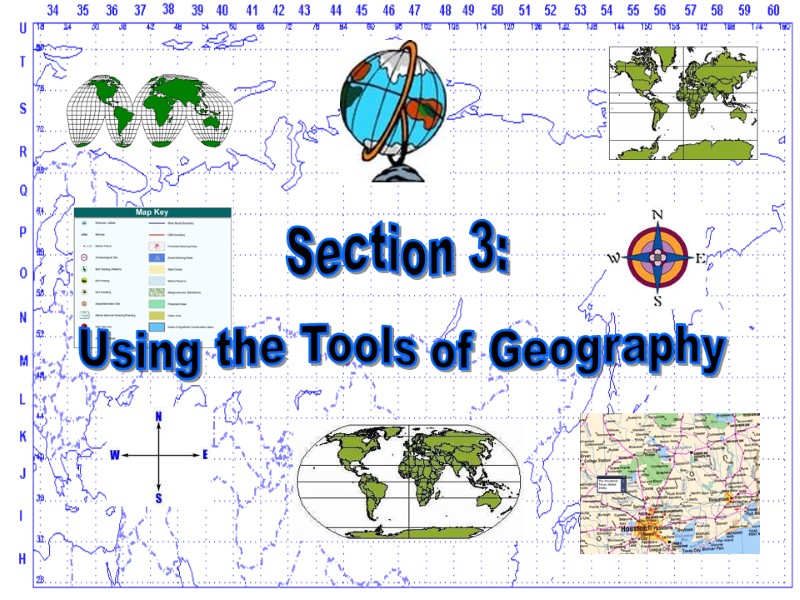








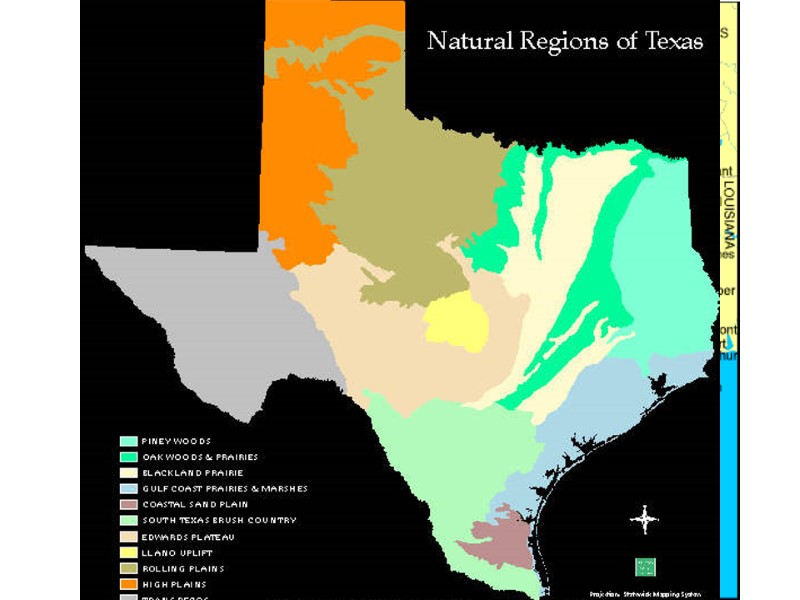


18146-using_geography_skills.ppt
- Количество слайдов: 43
 Chapter 1: Using Geography Skills
Chapter 1: Using Geography Skills
 Section 1: Understanding the Earth
Section 1: Understanding the Earth
 Things to Think About… How does the movement of the Earth around the sun affect our environment? What is the effect of latitude on climate?
Things to Think About… How does the movement of the Earth around the sun affect our environment? What is the effect of latitude on climate?
 The sun is a star in our galaxy called the Milky Way It provides light & energy needed for life on Earth It affects our environment (our surroundings) in countless ways. The Earth, Sun, and Our Environment
The sun is a star in our galaxy called the Milky Way It provides light & energy needed for life on Earth It affects our environment (our surroundings) in countless ways. The Earth, Sun, and Our Environment
 Day & Nights The Earth travels around the sun in an oval shaped path called an orbit. It takes 365 ½ days for it to complete one revolution or journey around the sun. The Earth spins around on its axis– an imaginary line running through its North & South poles.
Day & Nights The Earth travels around the sun in an oval shaped path called an orbit. It takes 365 ½ days for it to complete one revolution or journey around the sun. The Earth spins around on its axis– an imaginary line running through its North & South poles.
 Seasons During the year days or nights might seem longer because of the Earth’s tilt on its axis. The Earth’s tilt/orbit cause changes in temperature.
Seasons During the year days or nights might seem longer because of the Earth’s tilt on its axis. The Earth’s tilt/orbit cause changes in temperature.
 Seasons The amount of warmth one feels depends on how directly the sun falls on a region. The amount of sunlight also affects how much food is produced.
Seasons The amount of warmth one feels depends on how directly the sun falls on a region. The amount of sunlight also affects how much food is produced.
 Effect of Latitude Imaginary lines, called lines of latitude, are east-west circles around the globe They divide the Earth into regions according to the sunlight they receive The equator is a latitude line that circles the Earth exactly halfway between the North & South pole.
Effect of Latitude Imaginary lines, called lines of latitude, are east-west circles around the globe They divide the Earth into regions according to the sunlight they receive The equator is a latitude line that circles the Earth exactly halfway between the North & South pole.
 Effect of Latitude On/near March 21 & September 23, the sun is directly over the equator making both days and nights exactly the same length These days are the spring and fall equinoxes.
Effect of Latitude On/near March 21 & September 23, the sun is directly over the equator making both days and nights exactly the same length These days are the spring and fall equinoxes.
 Effect of Latitude Two other major lines of latitudes are the Tropic of Cancer and the Tropic of Capricorn
Effect of Latitude Two other major lines of latitudes are the Tropic of Cancer and the Tropic of Capricorn
 Effect of Latitude There are times in the year when the sun is directly over both the Tropic of Cancer and Capricorn creating the summer & winter solstices in the Northern Hemisphere summer solstice June 21 or 22 when over the Tropic of Cancer winter solstice December 21or 22 when over the Tropic of Capricorn During these times, the seasons are opposite in the Southern Hemisphere. Question: What is the significance of June 21 and December 21?
Effect of Latitude There are times in the year when the sun is directly over both the Tropic of Cancer and Capricorn creating the summer & winter solstices in the Northern Hemisphere summer solstice June 21 or 22 when over the Tropic of Cancer winter solstice December 21or 22 when over the Tropic of Capricorn During these times, the seasons are opposite in the Southern Hemisphere. Question: What is the significance of June 21 and December 21?
 Effect of Latitude The area between the Equator, the Tropics, and the Arctic/Antarctic circles also have specific names and characteristics. low latitudes: area between the Tropics of Cancer and Capricorn; receives direct sunlight; almost always hot high latitudes: area between the Arctic/Antarctic Circles and the North/South poles; a.k.a. “polar zones”; no direct sunlight; always cold middle latitudes: area between the Tropics and Circles; a.k.a. “temperature zones”; have all seasons: spring, summer, fall, winter
Effect of Latitude The area between the Equator, the Tropics, and the Arctic/Antarctic circles also have specific names and characteristics. low latitudes: area between the Tropics of Cancer and Capricorn; receives direct sunlight; almost always hot high latitudes: area between the Arctic/Antarctic Circles and the North/South poles; a.k.a. “polar zones”; no direct sunlight; always cold middle latitudes: area between the Tropics and Circles; a.k.a. “temperature zones”; have all seasons: spring, summer, fall, winter
 Effect of Latitude
Effect of Latitude
 Review… Orbit Revolution Rotation How does latitude affect climate? Give an example How does the Earth’s rotation affect our environment?
Review… Orbit Revolution Rotation How does latitude affect climate? Give an example How does the Earth’s rotation affect our environment?
 So, What’s the Big Idea? The relationship between the Earth and the sun creates our days, seasons, and climate, and influences our environment.
So, What’s the Big Idea? The relationship between the Earth and the sun creates our days, seasons, and climate, and influences our environment.
 Your Turn…. Create a graphic organizer that illustrates the main idea and its supporting details. You can create your own main idea or use the one provided. You may help one another, but it’s NOT a group or pair assignment. Everyone needs to turn one in.
Your Turn…. Create a graphic organizer that illustrates the main idea and its supporting details. You can create your own main idea or use the one provided. You may help one another, but it’s NOT a group or pair assignment. Everyone needs to turn one in.
 Section 2: Five Themes of Geography
Section 2: Five Themes of Geography
 Things to Think About… What is geography? How can the 5 themes of geography help you understand the world?
Things to Think About… What is geography? How can the 5 themes of geography help you understand the world?
 Geography The study of Earth from different points of view. Geographers (people who study geography) study: plant life landforms people how people & the Earth affect each other
Geography The study of Earth from different points of view. Geographers (people who study geography) study: plant life landforms people how people & the Earth affect each other
 Themes of Geography Geographers focus on two questions when working: Where are things located? Why are they there? They organize information into 5 themes: location place human-environment interaction movement regions
Themes of Geography Geographers focus on two questions when working: Where are things located? Why are they there? They organize information into 5 themes: location place human-environment interaction movement regions
 LOCATION Geographers study a place be describing it. Find absolute location using two types of imaginary lines: latitude & longtitude 1. Parallels: east-west circles around the globe; also called latitudes; describe location as north/ south of Equator; divide globe into units called degrees. 2. Meridians: north-south circles around the globe; also called longitudes; begin & end at the N and S poles; describe location as east/west of Prime Meridian Prime Meridian (runs through Greenwich, England) is 0° longitude 5 Themes
LOCATION Geographers study a place be describing it. Find absolute location using two types of imaginary lines: latitude & longtitude 1. Parallels: east-west circles around the globe; also called latitudes; describe location as north/ south of Equator; divide globe into units called degrees. 2. Meridians: north-south circles around the globe; also called longitudes; begin & end at the N and S poles; describe location as east/west of Prime Meridian Prime Meridian (runs through Greenwich, England) is 0° longitude 5 Themes
 LOCATION
LOCATION
 LOCATION 5 Themes
LOCATION 5 Themes
 PLACE 5 Themes Includes a location’s physical & human features. To describe an area you might include the following: Climate (how hot or cold) Population (number of people living there) Regions (plains, gulf coast)
PLACE 5 Themes Includes a location’s physical & human features. To describe an area you might include the following: Climate (how hot or cold) Population (number of people living there) Regions (plains, gulf coast)
 HUMAN-ENVIRONMENT INTERACTION 5 Themes Focuses on how people affect or change the physical characteristics of their environment OR how their environment affects them Example #1: environment affecting people: Mexico had very little rain and crops were getting ruined, so they had to borrow water from the USA. Example #2: people affecting environment: A lot of people were migrating to the west in the 1800s, so people started chopping down trees to make room and to build their homes. Huge forests were destroyed.
HUMAN-ENVIRONMENT INTERACTION 5 Themes Focuses on how people affect or change the physical characteristics of their environment OR how their environment affects them Example #1: environment affecting people: Mexico had very little rain and crops were getting ruined, so they had to borrow water from the USA. Example #2: people affecting environment: A lot of people were migrating to the west in the 1800s, so people started chopping down trees to make room and to build their homes. Huge forests were destroyed.
 MOVEMENT 5 Themes Explains the relationship between places and how people, goods, and ideas get from one place to another. Example: When the Spanish came to Mexico, they brought their religion, animals, and foods with them. This eventually helped create what we know about the Mexican culture (Catholicism, importance of horses, spices)
MOVEMENT 5 Themes Explains the relationship between places and how people, goods, and ideas get from one place to another. Example: When the Spanish came to Mexico, they brought their religion, animals, and foods with them. This eventually helped create what we know about the Mexican culture (Catholicism, importance of horses, spices)
 REGIONS 5 Themes Used to make comparisons and usually grouped by one unifying characteristic such as: Climate Land Population History Example: People who live in the desert have a much different life than people who live in the country.
REGIONS 5 Themes Used to make comparisons and usually grouped by one unifying characteristic such as: Climate Land Population History Example: People who live in the desert have a much different life than people who live in the country.
 REGIONS 5 Themes
REGIONS 5 Themes
 Review… Parallel Degree meridian Why do people study geography? What are the 5 themes of geography?
Review… Parallel Degree meridian Why do people study geography? What are the 5 themes of geography?
 So, What’s the Big Idea? Geographers study the Earth according to the five themes: location, place, human-environment interaction, movement, and regions
So, What’s the Big Idea? Geographers study the Earth according to the five themes: location, place, human-environment interaction, movement, and regions
 Your Turn…. FILL IN ASSIGNMENT
Your Turn…. FILL IN ASSIGNMENT
 Section 3: Using the Tools of Geography
Section 3: Using the Tools of Geography
 Things to Think About… What are the advantages and disadvantages of globes and maps in showing the Earth’s surface? How did Mercator try to create an accurate map? What are the parts of a map?
Things to Think About… What are the advantages and disadvantages of globes and maps in showing the Earth’s surface? How did Mercator try to create an accurate map? What are the parts of a map?
 Globes & Maps As people explored the earth they collected information about the land To present information accurately they put in on a globe — a round model of the Earth The globe was an accurate representation of continents except the difference in the scale — or size. Problem with globes: not enough detail or small enough for convenience. Flat maps were created Problem with flat map: there were distortions — changes in the accuracy of shapes and distance
Globes & Maps As people explored the earth they collected information about the land To present information accurately they put in on a globe — a round model of the Earth The globe was an accurate representation of continents except the difference in the scale — or size. Problem with globes: not enough detail or small enough for convenience. Flat maps were created Problem with flat map: there were distortions — changes in the accuracy of shapes and distance
 1569- Gerhardus Mercator created flat map to help sailors He expanded the area between longitudes near the poles making areas near poles bigger than they are The Mercator projection — method of putting a map of Earth on a flat piece of paper— is still used in deep-sea navigation Making Maps
1569- Gerhardus Mercator created flat map to help sailors He expanded the area between longitudes near the poles making areas near poles bigger than they are The Mercator projection — method of putting a map of Earth on a flat piece of paper— is still used in deep-sea navigation Making Maps
 Other techniques-interrupted projection-show accurate shape of land on flat surface Many believe Arthur Robinson’s projection is the best world map-it shows accurate shapes of land and oceans Problem with Robinson’s is that it still has distortions on the edges of map Making Maps
Other techniques-interrupted projection-show accurate shape of land on flat surface Many believe Arthur Robinson’s projection is the best world map-it shows accurate shapes of land and oceans Problem with Robinson’s is that it still has distortions on the edges of map Making Maps
 Making Maps
Making Maps
 Parts of a Map •Map symbols allow people to read and understand a map. The most important part of a map is the compass rose —which is a model of compass. It tells the cardinal directions —which are north, south, east, and west. Maps also have indicator for scale —tells what a certain distance on the map stands for on the surface of the earth.
Parts of a Map •Map symbols allow people to read and understand a map. The most important part of a map is the compass rose —which is a model of compass. It tells the cardinal directions —which are north, south, east, and west. Maps also have indicator for scale —tells what a certain distance on the map stands for on the surface of the earth.
 Parts of a Map Certain symbols on maps are used to indicate landmarks like roads, rivers, & towns. These symbols are explained in the key — or legend Most maps include a grid — blue lines representing latitude/longitude; some use letters and numbers
Parts of a Map Certain symbols on maps are used to indicate landmarks like roads, rivers, & towns. These symbols are explained in the key — or legend Most maps include a grid — blue lines representing latitude/longitude; some use letters and numbers
 Parts of a Map
Parts of a Map

 Review… Gerhardus Mercator Distortion Scale What is the main problem with the interrupted projection? Why are the different parts of a map important?
Review… Gerhardus Mercator Distortion Scale What is the main problem with the interrupted projection? Why are the different parts of a map important?
 So, What’s the Big Idea? Representing the Earth as a globe and as a flat map presents different problems.
So, What’s the Big Idea? Representing the Earth as a globe and as a flat map presents different problems.

